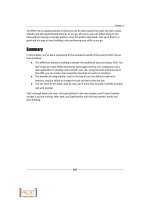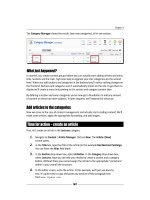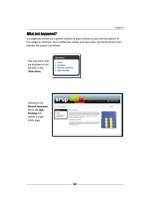Joomla cho người mới bắt đầu part 4 pptx
Bạn đang xem bản rút gọn của tài liệu. Xem và tải ngay bản đầy đủ của tài liệu tại đây (1.54 MB, 10 trang )
Chapter 2
[ 37 ]
If you're having trouble installing Joomla!, chances are your problem has already
been solved on the ocial Joomla! forum dedicated to installaon issues. On
, look for the Installaon secon:
You can also point your browser directly to />viewforum.php?f=429.
Point your browser to www.joomm.net,the website accompanying
this book, to nd answers to frequently asked Joomla! quesons.
Pop quiz – test your knowledge of installing Joomla!
1. Why do you need FTP soware before you can install Joomla!?
a) To unzip the in stallaon package.
b) To upload les from your com puter to the web server.
c) To backup your site.
2. What are the main steps in installing Joomla!?
a) First upload the Joomla! les, then run the web installer.
b) Download Joomla!, upload the les, create a database, then run the
web installer.
c) Download Joomla!, upload the les, run the web installer, create
a database.
Download at Wow! eBook
WWW.WOWEBOOK.COM
Installaon: Geng Joomla! Up and Running
[ 38 ]
3 What username and passwords do you have to enter in the Joomla! web
installaon wizard?
a) The username and password needed to log in to the Joomla! backend.
b) The username and password needed to access the MySQL database.
c) The username and password needed to access the MySQL database, and
the password needed to log in to the Joomla! backend.
Summary
In this chapter, you've learned how to install Joomla!. Specically, we covered:
The most common way to install Joomla!—using a web server. This way, the site you
build is accessible through the Internet immediately. For tesng purposes, you can
also install Joomla! on your own computer.
To be able to install and run Joomla!, you'll need hosng space and FTP soware
to put the required les on a web server. You might want to install a few
dierent browsers.
Installing Joomla! takes four steps:
First, you get the current Joomla! le package from
www.joomla.org.
Then, using FTP, you place the downloaded les on your
hosng space.
The last step before actually installing Joomla! is creang a
database; for this you can use the control panel provided by
your web hosng provider.
The nal step is running the Joomla! web installer in your browser.
This guides you through the installaon process.
The output of the Joomla! installaon has two faces. The Joomla! frontend displays
an example website that is publicly accessible, whereas the backend is Joomla!'s
web management interface where just one VIP is allowed to login—you!
Now that you've got Joomla! up and running, it's about me to nd out what this great
new web development tool can do. In Chapter 3, you'll explore the Joomla! frontend and
backend, and you'll get a rst taste of building websites the Joomla! way.
3
First Steps: Getting to Know Joomla!
Congratulaons! You have just installed Joomla!. This means you can now step
into Joomla!, and start using one of the most excing and powerful web build-
ing tools. Before you begin building your own site in the next chapter, let's take
some me to get acquainted with the way Joomla! works. The system has a
clean, user-friendly interface that's easy to learn and fun to work with; you'll
be amazed at how fast you can perform content management magic in just a
few clicks. This chapter introduces you to Joomla!'s basic funcons.
In this chapter you will:
Get acquainted with the Joomla! way of building and maintaining websites.
Explore the user interface; try out the main screens and toolbars.
Examine the Joomla! example website that you've installed. What are the main
features and special funcons that Joomla! oers out of the box?
Get your feet wet and try out some of the most common administraon tasks.
Publish your rst content, change a few things, and tweak a few sengs.
This way you'll get a taste of what it's like to use Joomla! as your web tool box and get ready
to build your own site in the next chapter. So let's get started!
First Steps: Geng to Know Joomla!
[ 40 ]
Making the switch: Building websites the Joomla! way
If you're new to Joomla! and to Content Management Systems (CMSes), you'll nd creang
sites using a CMS takes a bit of geng used to. Even if you have some experience building
websites, you'll have to adapt to a dierent way of working. But it's worth your while, and
Joomla! will make it easy on you—really! Before we explore the example site you've installed
in the last chapter, we'll have a brief look at just what's so dierent about building websites
with Joomla!.
As you may know, ages ago—at least before 2005 when Joomla! came to be—most websites
were handcraed. Creang a website meant creang pages. For every web page you needed,
you had to create an HTML document. You would design a basic page layout and reuse that
over and over again, adding new pages and adapng the layout to t the type of content.
Whatever tool you used—Adobe (then Macromedia) Dreamweaver, Microso FrontPage,
or maybe a plain text editor—you would be designing, coding, eding, or building the same
web page your visitors would see on your website.
Geng anything published on the Web meant uploading pages (HTML documents) to a web
server. Adding and updang content or managing hyperlinks was basically handicra. You'd
open a page in an editor, make changes, and upload it to the web server again. Those were
the bad old days of stac websites.
However, those days are long, long gone. Today, most websites are dynamic. They use a CMS
to make it easier to create and manage content. These CMS-based sites are either built from
scratch (by web programmers creang a custom CMS to meet specic client requirements)
or based upon a generic CMS such as Joomla! that can be customized and expanded. And it's
that dynamic bit that makes working with a CMS so all-new and dierent.
Sorry, web pages have ceased to exist
Okay, now brace yourself for the main dierence between the stac old school approach and
building websites using a CMS such as Joomla!: there are no web pages.
Of course, a visitor browsing your site sll experiences that website as—basically—a
collecon of pages. In Joomla!, however, the page your visitor sees isn't really a page. Rather,
it's a collecon of lile blocks of interacve data that the CMS pulls from a database. These
blocks can be arranged and combined into web pages in many dierent ways.
As soon as your visitor clicks on a link, he actually sends a request to Joomla! to assemble
bits and pieces of data to present a full web page. If your site visitor clicks on Home, he'll
see a page consisng of headings, images, and teaser texts. If he clicks on a Read more link,
a new mix of data is displayed. This can consist of the same arcle heading from the home
page, possibly the same intro text and image (now combined with the full body text) links to
related arcles, banners, and dierent menu opons.
Chapter 3
[ 41 ]
When creang stac websites, the HTML page you designed would be the exact same HTML
page the site visitor would see. This one-to-one relaonship has gone out the window.
Behind the scenes, in Joomla!, you won't be eding pages—aer all, there are no pages in
Joomla!. To change the output (the web page) you edit the dierent building blocks. These
blocks can be any part of the nal page: the main arcle, a menu entry, a banner, or a list of
hyperlinks to related items.
A CMS is like a coee machine system
In a way, a CMS works like a big mul-opon coee machine. The user presses
a buon to select any of the available opons; the machine invisibly fetches all
of the required ingredients and mixes these to serve a cup of fresh coee, lae,
frappuccino, or decaf.
This is similar to the way a CMS serves content. The user clicks on a link, the
mighty machine gathers whatever combinaon of content parts is needed from
the database to complete this parcular order and it pours the output into a
coee cup—I mean, a web page.
Why is this a good thing?
The dynamic approach of CMSes, such as Joomla!, makes creang websites much more ex-
ible. You don't have to manually create dozens of rigid content pages, copying menus and
other common elements from page to page as you extend your site. Instead, you'll choose a
basic page layout and add any combinaon of building blocks you need:
Do you want a home page with four headings, teaser texts, Read more links, a main
menu, a random image, a login form, or a list of links to popular arcles? You can do
this easily, as the Joomla! CMS allows you to combine dierent blocks of content
into your home page. No programming skills needed!
Download at Wow! eBook
WWW.WOWEBOOK.COM
First Steps: Geng to Know Joomla!
[ 42 ]
If your site has a secon about digital photography, do you want all content pages
about DSLR cameras to display a special banner to aract aenon to your special
newsleer on the subject? In Joomla!, it's a breeze.
Would you like to have dierent items on your home page on every day of the
week? Do you want to set a parcular starng date and an ending date for pub-
lishing your arcles? It's all possible. While you're on a holiday, you can have your
home page automacally updated with the arcles you prepared beforehand!
To summarize: you've got the power! You determine what "content blocks" Joomla! packs
together onto any specic page and you also set the order and the layout of these blocks on
the browser screen.
All of this magic is made possible by Joomla!'s built-in PHP wizardry. It uses the powerful PHP
scripng language to communicate with a database, gathering just the blocks of data you
need and presenng them the way you want.
A website built of blocks
Now what does this building blocks thing look like in real life? The following is an illustraon
of Joomla!'s page building system dissected:
Chapter 3
[ 43 ]
A web page in Joomla! basically consists of these three parts: a base layout (1), the main
content block (2), and as many funcon blocks as you like (3).
(1) The base layout: This denes the presentaon of all content (the amount of
columns, background colors, header graphics, and so on). This base layout also
contains "posions" (spaces Joomla! can ll with its content blocks). In Joomla!, this
base layout is dened in a template. Generally, you set the template once and forget
about it. It controls the graphic design; it's not part of your daily roune of content
management. You'll learn more about using templates in Chapter 11.
(2) The main content area: This is the essenal part; it contains the cold hard con-
tent. Whether you'll publish an arcle, show a contact form, or a photo gallery it
will appear here. In Joomla!, this area is called the mainbody. In most cases, the
mainbody appears in the middle of the page.
(3) The blocks around the main content area: Examples are the Main Menu in the
le-hand sidebar, Latest News, and so on. These blocks are called modules. Modules
can contain advanced funconality: menus, polls, login forms, dynamic lists, random
images, slideshows, and so on. Anything in the top, le, right, or boom of a Joom-
la! page is displayed using modules. The default Joomla! installaon comes with
dozens of modules; the system is very extensible.
To su mma ri ze: the te mpl ate fu nc on s a s a f rame ; the m ain bo dy is th e cen tral an d ess en al
building block that ts right in the middle; and modules are blocks that you can add and arrange
around that, just the way you like, to add essenal funcons (or just fun and pizzazz) to your site.
Introducing frontend and backend: The Joomla! interface
Okay, so how does all this joomling around with building blocks work? How do you get the
mainbody to show content the way you want to? How do you work with modules? To answer
these quesons, we'll rst have a look at the toolkit Joomla! oers you to manage your site.
The Joomla! interface features a workspace that contains all tools and controls you'll need
for any web building magic.
First Steps: Geng to Know Joomla!
[ 44 ]
The following screenshot shows the two faces of the Joomla! example site: the frontend and
the backend.
Your workspace: The backend
As you know, Joomla! is a web applicaon. It's a soware tool that's installed on a web
server and that's accessed through a browser. Creang and managing a site with Joomla! is
an online acvity. Wherever you are, if you have Internet access you can log in to the Joomla!
administraon interface to manage your site.
This means every Joomla! site has a "sta entrance" your site visitors will never get to
see. It's the administraon interface or backend of your site. By default, only the site
administrator has permission to log in to the backend; later on, the administrator can give
other contributors access. Although there's also such a thing as frontend eding, generally
you will administer your site using the backend. The backend is the interface for all site
management tasks, such as adding content, changing menus, or customizing the layout.
And what's that frontend thing, then?
The public face of your Joomla! site is called—you might have guessed it—the frontend.
That's just another word for "your website as the visitor sees it".
In the rest of this chapter, you'll learn more about these two basic noons in Joomla!. First,
we'll take a closer look at the frontend (the nal output of whatever you do in Joomla!).
Chapter 3
[ 45 ]
Exploring the Joomla! example website, we'll check out the many features the CMS oers
you right out of the box. Aer that, we'll examine how the backend works and get our hands
dirty with some real life content management acvies.
The frontend: The website as the user sees it
Let's rst explore the elements of the default Joomla! example site home page. This will
give you a good overview of the dierent modules that Joomla! features out of the box.
The example site that's part of the default installaon is just one of the many types of sites
you can build with Joomla!. As you can see, the example is focused on presenng quite a
lot of (some might say, too much) informaon, the home page pulling the reader towards
the content through intro texts, banners, link lists, a poll, several menus, and so on. It's very
much focused on text; the only image you'll see is a banner ad at the boom.
Download at Wow! eBook
WWW.WOWEBOOK.COM
First Steps: Geng to Know Joomla!
[ 46 ]
The previous picture of the home page shows the following elements:
News Flash: Shows a random news ash each me the page is loaded
Top Menu: A menu at the top of the page
Breadcrumbs: The pathway to the current page
Search: The search box—the search results are shown in the main content area
In the le-hand side column: Three dierent menus, and a login form
Latest News: Links to the most recent news items
Popular: Links to the most read arcles
In the right-hand side column: Three separate blocks—Poll, Who's Online,
and Adversements
Mainbody of the Front Page: Introductory text of selected arcles
This site perfectly demonstrates what Joomla! is capable of. The fact that it's already
packed with arcles, menus, and extras gives you a great opportunity to try out Joomla!'s
capabilies and decide for yourself which features t your site's needs.
You're certainly not limited to building the kind of informaon-rich sites the
example site demonstrates. In Chapter 1, you've seen a few other examples
of Joomla! sites ranging from small personal blogs to huge corporate and e-
commerce sites. Later on, you'll learn how to customize the sample site to
create a much cleaner look that might beer t your needs.
Download at Wow! eBook
WWW.WOWEBOOK.COM









